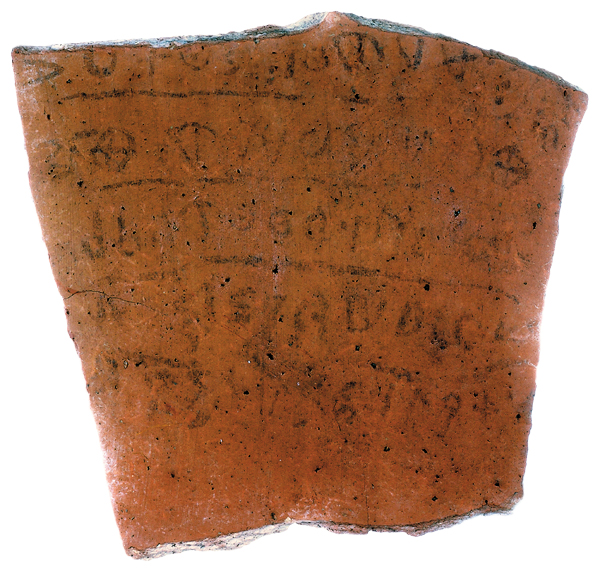
Four contenders vie for the honor of the oldest Hebrew inscription. To decide we must determine (1) whether they are in Hebrew script and/or language and (2) when they date. Not easy!
The first contender, the already famous Qeiyafa Ostracon, was discovered only in 2008 at Khirbet Qeiyafa, a site in the borderland of ancient Judah and Philistia.a The five-line ostracon (an ink inscription on a piece of broken pottery) is not well preserved and is subject to varying readings.
As the Qeiyafa Ostracon is a recent find, so the Gezer Calendar is an old one. It was discovered exactly a hundred years earlier, in 1908, by Irish archaeologist R.A.S. Macalister at Tel Gezer, between Jerusalem and Tel Aviv. It describes agricultural activities over a 12-month period. Inscribed on a piece of soft limestone, it is sometimes supposed to be a schoolboy’s ditty.
The third contender, like the first one, was recently discovered (2005), but it is not composed of words. It is what scholars call an abecedary, that is, an inscribed alphabet, sometimes thought to be a young scribe’s practice work. The Tel Zayit Abecedary, named for the site south of Jerusalem where it was found, is incised on stone.
The last contender can be paired with the third, for it, too, is an abecedary, excavated in the late 1970s at a site called Izbet Sartah in the low hills (the Shephelah) of Judah. The site is generally thought to be Ebenezer, where the Israelites mustered in a battle with the Philistines when they captured the Ark (1 Samuel 4).
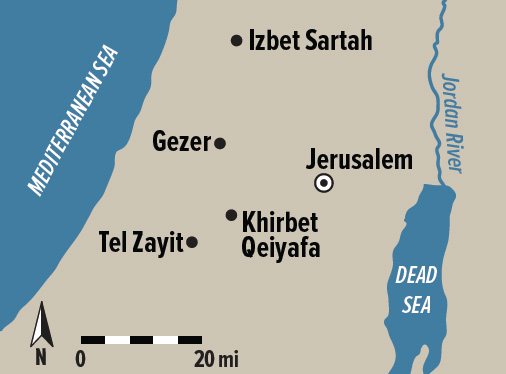
While these inscriptions will be the focus of this article, a few hundred other Old Hebrew inscriptions have been excavated in ancient Israel dating from the ninth through sixth centuries B.C.E. Unlike the four contenders in this article, these inscriptions are unquestionably Old Hebrew, both in script and in language, but are later than the inscriptions we will be considering.
Script and language are two very different things. This is an important point that is often forgotten in debates about inscriptions. For example, the alphabet used to write most Western European languages is the Latin alphabet. Thus the sentence “Rien ne l’intéresse” (“Nothing interests him”) is written in the French language, but the script is Latin. Similarly the words “
Let’s now move back in time to set the stage. The alphabet was invented in the early second millennium B.C.E.c I call the script of these early alphabetic inscriptions simply Early Alphabetic, although some scholars prefer the term Canaanite or even Proto-Sinaitic. During the entire period when this script was used, the same letter (grapheme, as an epigrapher would say) was often written in a variety of ways. In other words, it was not a very standardized writing system. The stance of the same letter could vary; it may “face” in one direction or another; or vary in other ways, such as how far it might lean to the right or to the left.
The direction of the writing would also vary. Some Early Alphabetic texts read right-to-left (sinistrograde); others left-to-right (dextrograde). Still others were written boustrophedon (“as the ox plows”), that is, consecutive lines would be written from left-to-right, then right-to-left, then left-to-right, etc. Occasionally, a text in Early Alphabetic script would even be written vertically, in columns (so-called columnar writing).
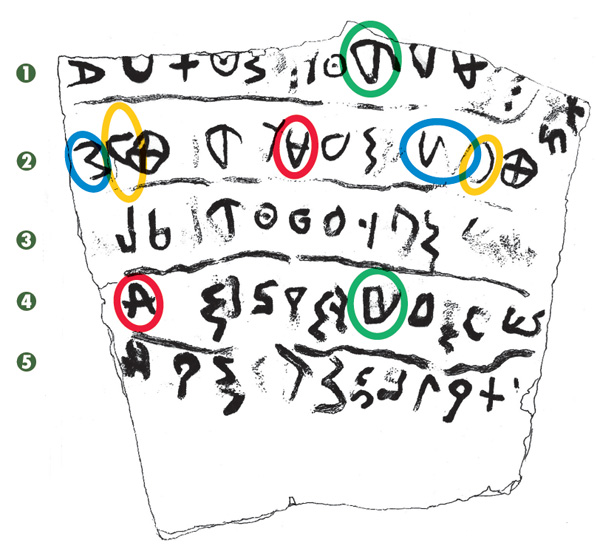
Moreover, this Early Alphabetic script included a larger stock of consonants, arguably as many as 27 or 28, not just the 22 letters of the later Phoenician alphabet.
At the end of the second millennium B.C.E., several seminal developments occurred: (1) The stance of the letters became more stabilized and standardized; (2) The direction of writing became consistently right-to-left; (3) Because of a number of consonant mergers (among other things), the number of consonantal letters was reduced to 22.1 (Vowels were not yet represented.) Because of these developments, the convention within the field of epigraphy is to refer to this next stage of the Northwest Semitic script as Phoenician. The changes from Early Alphabetic occurred gradually, but by around the mid-11th century B.C.E. these changes were in place. The Phoenician script is the heir of the Early Alphabetic script.
And this Phoenician script is the mother script of the Old Hebrew script. That is, the Old Hebrew script derived directly from the Phoenician script. The Old Hebrew script did not derive directly from the Early Alphabetic script.
In terms of the time frame for the rise of the Old Hebrew script, I agree with the great Israeli epigrapher Joseph Naveh that this Old Hebrew script cannot be distinguished from the Phoenician script until the ninth century B.C.E.2 That is, the epigraphic evidence demonstrates that Old Hebrew script does not branch off from the Phoenician script until the ninth century B.C.E. (More on this later in this article.)
The Old Hebrew language, however, certainly existed prior to the ninth century B.C.E. (Texts written in the Old Hebrew language prior to the ninth century would have been written in the Phoenician script, the “mother script” of Old Hebrew.) In fact, we actually have texts in the Old Hebrew language that very probably antedate the ninth century B.C.E. (but they are found in the Hebrew Bible, not in ancient inscriptions that have been recovered from the ground)—the Song of the Sea (Exodus 15), the Song of Deborah (Judges 5), the Blessing of Moses (Deuteronomy 33) and Jacob’s prophecy (Genesis 49). Scholars generally agree that these poetic texts date to the 12th or 11th centuries B.C.E.3
In short, we have examples of Old Hebrew texts from a period before we can identify a distinctive Hebrew script.
Complicating things still further, it is often difficult to determine just what ancient language an inscription is written in. After all, the same set of consonants often appears in different Semitic languages with the same or slightly different meanings. Thus a set of consonants may look the same but the language may be Hebrew, Moabite, Ammonite, Ugaritic, Aramaic, etc.
For example, the standard Hebrew word for “dog” is written with these consonants: klb. But no trained epigrapher would read this word in an inscription and automatically assume that it must be Hebrew, for the word dog is spelled klb not just in Old Hebrew, but also in languages such as Phoenician and Aramaic. Similarly with the word for “son,” which is spelled bn in Hebrew, but bn is also son in Phoenician, Ammonite and Moabite.
Words with the same consonants may also have been pronounced differently in different languages, and the writing systems of the Iron Age Levant (e.g., Hebrew, Aramaic, Phoenician, Ammonite, Moabite, Edomite, Philistine) did not represent vowels with any precision even after they were introduced. And Phoenician writing was strictly consonantal throughout most of the Iron Age; vowels are not represented in this script.
Hebrew writing was primarily consonantal, but early on Hebrew began using matres lectionis (“mothers of reading”), that is, using certain consonants to signify certain vowels also. At first, these matres lectionis were used to represent only long vowels that occurred at the end of a word. Thus, a final yud (y) could be signifying a vowel and pronounced ī, rather than simply being the consonant y. Just when you think it’s clear, however, it becomes more complicated: A final heh (scholars write it simply he), normally pronounced h, was used to signify not just the consonant heh but it could also be used to signify three different vowels: ā, ē or ō. This of course creates some additional ambiguity.
Then, at the end of the eighth century B.C.E., Old Hebrew scribes also began using matres lectionis for certain internal long vowels, that is, for vowels within a word. Thus waw was sometimes used for ū, and yod was sometimes used for ī. A similar development occurred in Iron Age Aramaic.
The long and short of it is that we are often not certain about the actual pronunciation of words in Iron Age Northwest Semitic languages—or even what language it is. Sometimes we can make such determinations; sometimes we cannot. It just depends on the nature and content of the inscription.
Another factor that can be important in determining the language of an inscription is provenance: Where did the inscription come from? An Iron Age inscription discovered in Moab is likely to be Moabite. But inscriptions can travel. For example, an inscribed seal found in a tomb in Amman that you might suppose would be Ammonite (or perhaps Aramaic) was actually written in the Moabite script.4 And there is an Old Hebrew inscription that was found in Nimrud (Assyria).5
A final difficulty is that we are often dealing with partially preserved languages. Most of the texts produced in antiquity simply did not survive the ravages of time. There is much about these ancient languages that remains unknown—and will likely never be known.
With this background we may now ask which of the four contenders is the oldest Hebrew inscription. Refining things a bit, this really involves three questions: (1) Is the script Hebrew? (2) Is the language Hebrew? (3) What is the date of the inscription—at least relative to the others?
Unfortunately, the five-line text of the Qeiyafa Ostracon is quite faded. Some of the letters are difficult to identify or are simply not there. There has been considerable debate among scholars about the actual readings. Found in an excavation directed by Hebrew University archaeologist Yosef Garfinkel, the text on the 6-by-6-inch potsherd is well-nigh impossible to reconstruct as a continuous text, so much so that the original editors did not even provide a translation of the text. Scholars have given varying identifications of the letters and partial reconstructions of the text. Among scholars who have tried their hand at it are famed Israeli epigrapher Ada Yardeni; excavator Yosef Garfinkel and his associated epigrapher from Hebrew University, Haggai Misgav; Haifa University professor Gershon Galil; senior epigrapher Émile Puech of the École Biblique et Archéologique Française; and I, too, have weighed in.6 Despite the differences in the interpretation, however, some things can be said. It is not a business or commercial document. The text seems to include words like “king,” “servant” and “judge,” so it is probably a literary or ethical text.
Is enough there to say that the script is Hebrew? The answer must be no.
From earliest times, as previously noted, Old Hebrew was written from right to left (sinistrograde). So was the earliest Phoenician script, from which Old Hebrew was derived. However, the Qeiyafa Ostracon, as far as we can tell, is written dextrograde (from left-to-right). Dextrograde writing is attested in linear Early Alphabetic texts, but it is simply not a feature of the Old Hebrew script (nor of Phoenician or Aramaic).
Moreover, there is substantial variation in the stance of several of the letters in the Qeiyafa Ostracon. For example, note the dramatic variation in the stance of ’alep. The stance of the ’alep in line 2 is 180 degrees different from its stance in line 4. The stance of the šin (in blue) at the beginning of line 2 (the left side of the ostracon) is not the standard W stance that is attested so well in Phoenician and Old Hebrew, but is here rotated 90 degrees from that stance. However, in the latter part of line 2, the stance of the šin (although only partially preserved) does appear to be the standard W stance. The stance of the pe at the beginning of line 2 (in yellow) faces right and at the end of the same line faces in the opposite direction! The bet (in green) is rotated 90 degrees counterclockwise from its traditional stance in Phoenician and Old Hebrew, but in line 4 the stance of the bet is dramatically different from the rest of the occurrences of bet in the ostracon.
Dextrograde writing and dramatic variations in stance are attested in Early Alphabetic writing but not in Phoenician or Old Hebrew.7 The conclusion is inescapable: The Qeiyafa Ostracon is written in Early Alphabetic script, not in the Phoenician or Old Hebrew script. On this, the original editors agree.8
Based on the identification of the script as Early Alphabetic, I would date the inscription as most likely coming from the 11th century B.C.E.
Even though the script might not be Hebrew, the text could be. As noted earlier, we know of Biblical (Hebrew) texts from the 12th or 11th centuries B.C.E. Is the language of the Qeiyafa Ostracon Hebrew?
Let me give you up front the conclusions of the principal scholars who have weighed in on the matter. Yosef Garfinkel, his excavation codirector Saar Ganor and his epigrapher Haggai Misgav in their editio princeps conclude—with some caution, however—that the language is Hebrew.
Émile Puech says the language could be Canaanite or Hebrew.
Gershon Galil has asserted in a fairly dogmatic fashion that it is Hebrew, and he is quite critical of the caution of the original editors.9
British scholar Alan Millard recently stated that he believes “the language may be Hebrew, Canaanite, Phoenician or Moabite.”10
My own view is that it is not possible to say with certainty that the language of this inscription is Hebrew.11
Most of the discussion has revolved around words or word roots (lexemes, in the jargon of the trade) that might be identified as Hebrew and only Hebrew, instead of with a variety of languages.
For example, the root mlk (king) arguably occurs in line 4. This is certainly a Hebrew root. But this root also occurs in numerous Semitic languages, including Ugaritic, Amorite, Phoenician, Punic, Moabite, Aramaic, Ammonite, Edomite, and even Palmyrene. Because this root occurs in so many ancient Semitic languages, it should be classified as Common Semitic. It definitely cannot be considered diagnostic for Hebrew.
Another important root for the original editors is ‘bd (servant) in line 1. But this root also occurs in numerous Semitic languages, including Ugaritic, Phoenician, Aramaic, Nabatean, Palmyrene, Ethiopic, and Classical and even Modern Arabic. The same thing can be said of the root špt (judge), and the root nqm (avenge). This doesn’t leave us much to go on, in terms of deciding on the language of this ostracon.
A key root for the original editors of the text (Garfinkel, Misgav and Ganor) is ‘sh (“to do”) in line 1. This root (technically, a lexeme) is their primary basis for the contention that the Qeiyafa Ostracon is Hebrew. At the outset, it should be noted that another distinguished epigrapher (Puech) does not read the lexeme in this way. That is, the root may not even be there. But even if it is, the verbal form also occurs several times in the Moabite language (e.g., in the famous Mesha Inscription on lines 3, 9
So in sum, the script of the Qeiyafa Ostracon is Early Alphabetic, the precursor of the Phoenician script. But the language of the inscription simply has no distinctive features that allow us to make a definitive statement as to its identification. The easiest position is to suggest that both the script and language are Canaanite and to leave it at that. After all, the script is definitely Early Alphabetic (i.e., “Canaanite”) and so the simplest conclusion is that the language is also Canaanite. Although nothing precludes the identification of the language as Hebrew, neither can a compelling case be made for the conclusion that it is Hebrew.
Someone might reply that this is a Judahite site and so the inscription must have been written in Hebrew. However, this too raises a question. Tel Aviv University archaeologist Israel Finkelstein questions whether this is a Judahite site. And it is important that we be careful not to use circular reasoning: that is, the site is Judahite because the Qeiyafa Ostracon is Hebrew and the Qeiyafa Ostracon is Hebrew because the site is Judahite. Finally, we may also note that a fledgling state will sometimes write in a foreign prestige language (here Phoenician or Canaanite), rather than its own native language. And also, as I mentioned earlier (with regard to the Moabite seal found in the Ammonite capital and the Hebrew inscription found in Assyria), inscriptions travel and so did the ancient scribes who wrote them. So provenance should normally not be the sole means of identifying what language a text is written in.
In sum, there is not sufficient evidence to make a decisive determination of the language of the Qeiyafa Ostracon.
Let us turn then to the Gezer Calendar: Can a better case be made here?
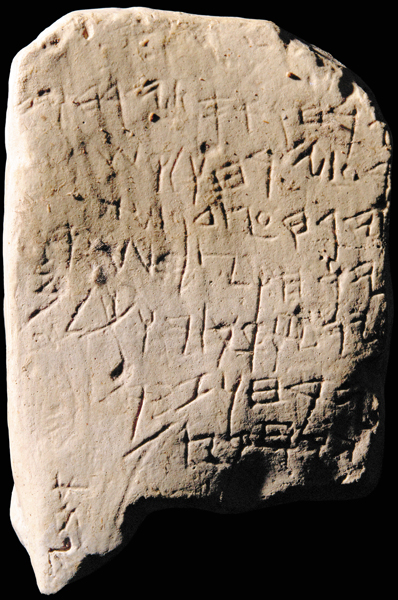
This tiny (3.5 x 6 inch) piece of limestone, now in the Istanbul Museum, describes seasonal agricultural activities—sowing, harvesting, and processing of flax and barley.
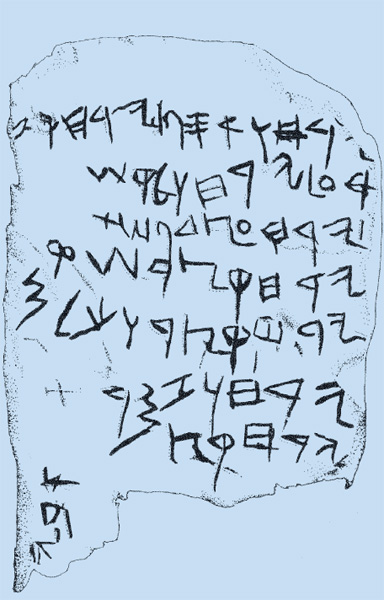
At the end of the inscription are three letters on the left at a right angle to the rest of the inscription. Johns Hopkins University epigrapher Kyle McCarter tentatively reads these letters as as “Abiya”—perhaps the author or the scribe.
Again, the question arises, What is its language?
Decades ago, the great Biblical archaeologist William Foxwell Albright stated emphatically that “the Gezer Calendar is written in perfect classical Hebrew.”13 Albright’s eminent student, Harvard epigraphist Frank Moore Cross, agreed, but he nuanced his assessment a bit by referring to it as “written in a Hebrew dialect.”14 More recently, Cross’s student (and my teacher) Kyle McCarter of the Johns Hopkins University has stated that he considers the language of the Gezer Calendar to have been “very close to Hebrew,” but adds that “the language in which the text is written seems also to contain features not found in later Hebrew inscriptions, so it is probably best to describe the language of the tablet as a dialect of South Canaanite rather than specifically as Hebrew.”15 Joseph Naveh has stated that “its language does not have any lexical or grammatical features that preclude the possibility of its being Phoenician.”16 In a forthcoming article, Dennis Pardee of the University of Chicago’s Oriental Institute has weighed in on the question. Assessing the totality of the evidence, he concludes that this inscription is indeed written in the Phoenician language.17
The situation is similar to the Qeiyafa Ostracon, at least in terms of lexemes or roots. For example, the word yrḥ (meaning “month”) occurs on every line of the Gezer Calendar and it occurs many times in the Hebrew Bible. But it also occurs in various other languages, including Ugaritic, Phoenician, Ammonite, Aramaic, Palmyrene and Nabataean. Similar statements can be made about words such as zr‘ (to sow), s´‘rm (barley) and lqš (late planting). There is simply no lexeme or linguistic feature in the Gezer Calendar that can be considered distinctively Hebrew. Someone might retort that this was an Israelite site and so this text must be Old Hebrew. But I’d respond to that statement about Gezer in the same fashion that I did with regard to Qeiyafa. Ultimately, provenance is not always the panacea that we might wish.
What about the script of the Gezer Calendar? Is it Hebrew script? Joseph Naveh has concluded that “No specifically Hebrew characters can be distinguished.”18 I concur. Although Frank Cross has declared the script Hebrew, he does so with caution: “So similar are Phoenician and Hebrew [scripts] in the tenth century [B.C.E.] that it has been difficult for epigraphists to establish whether the Gezer Calendar was written in a Hebrew or in a Phoenician script,” but he believes he can see “the first rudimentary innovations that will mark the emergent Hebrew script.” Then, however, he states that these features are “faint at best.” In terms of script typology, I believe that the script of the Gezer Calendar is Phoenician, not Old Hebrew script.19 In terms of date, I consider the script of the Gezer Calendar to reflect a date in the late tenth century or the very early ninth century B.C.E., that is, not as old as the Qeiyafa Ostracon.
There are thus strong voices suggesting caution about concluding that either the language or the script of the Gezer Calendar is Hebrew.
With regard to the Tel Zayit Abecedary and the Izbet Sartah Abecedary there is only one question: Is the script Hebrew? We cannot ask whether the language is Hebrew because the inscription is simply a series of letters arranged in alphabetical order, nothing more.
The Tel Zayit Abecedary was recently found carved in stone at a site southwest of Jerusalem in an excavation directed by Ron Tappy of the Pittsburgh Theological Seminary, with Kyle McCarter serving as the excavation’s epigrapher.
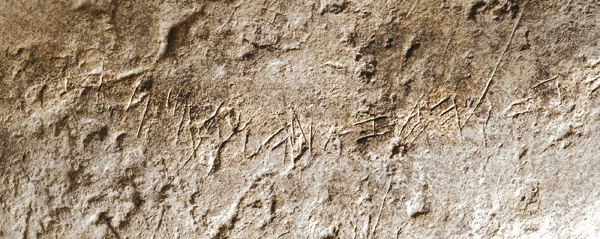
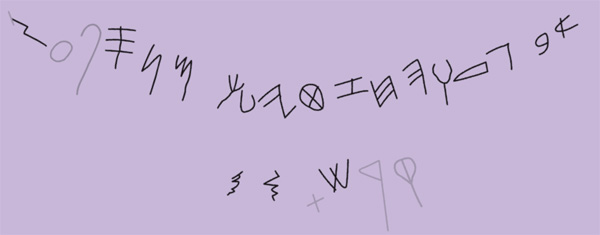
Analyzing the inscription letter by letter, McCarter concludes that it is a transitional script—not Phoenician, but not yet Hebrew. In his words, “It already exhibits characteristics that anticipate the distinctive features of the mature Hebrew national script.”20
My own view is that it is pure Phoenician. The difference between us is small and technical. McCarter finds some elongation of certain letters that places them beyond Phoenician, but not yet the distinctive Old Hebrew script. I find this elongation in certain Phoenician texts of this period.
I would date the Tel Zayit inscription to the late tenth century or the very early ninth century B.C.E., slightly later than Tappy dates the archaeological context. The Tel Zayit Abecedary and the Gezer Calendar are thus contemporaneous. Although Tel Zayit is Judahite, early Israelites had no difficulty using Phoenician script, as we have seen. Incidentally, McCarter regards the abecedary as evidence of Judahite literacy, especially because Tel Zayit is at the western frontier of the kingdom and distant from the capital Jerusalem.21
The final contender, the Izbet Sartah Abecedary, was discovered in an excavation led by Moshe Kochavi and his then student Israel Finkelstein of Tel Aviv University. It was analyzed by their paleographer Aaron Demsky. The Izbet Sartah Abecedary is clearly the earliest of the four inscriptions we have been considering (about 1200 B.C.E.). But it is also the easiest to dispose of if the only question is whether it is a Hebrew inscription. Since it is an abecedary, we can ask only whether the script is Old Hebrew. There are no words on the basis of which we could consider whether the language is Hebrew. The script, however, is clearly Early Alphabetic, that is, even earlier than the Phoenician alphabet, which was precursor to the Old Hebrew alphabet. Note that there is much variation in stance and the abecedary of line five is clearly written from left-to-right not right-to-left like Hebrew script. When the Izbet Sartah ostracon was found, Frank Cross chided those who wished to suggest that it should be classified as “Hebrew.” He said “I have no doubt that the Old Canaanite pictographic alphabet and Linear Phoenician, and probably as well the Canaanite cuneiform alphabet (‘Ugaritic’) were widely used in Israel throughout this era.” Then he goes on to say that “the issue in question, though, is when a Hebrew national script tradition broke away from the Old Canaanite or Early Linear Phoenician script” and became an independent “Hebrew” script.22 His conclusion is resounding and dead on: Certainly not nearly as early as Izbet Sartah. So the Izbet Sartah Abecedary is out of the running. Some might suggest that its provenance is an Israelite site, but that simply adds speculation to speculation.
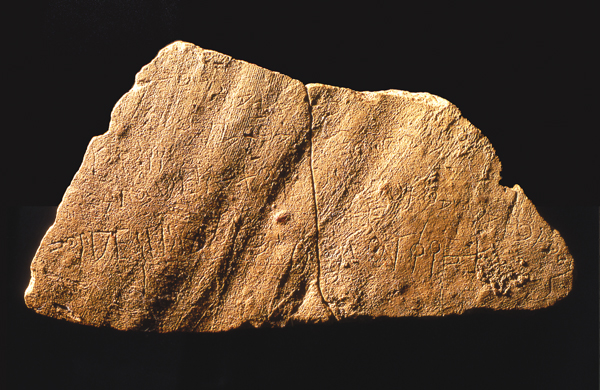
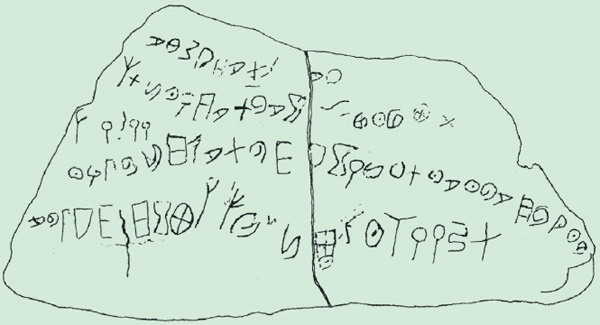
At the end of the day, I conclude that none of this quartet of inscriptions can be declared the winner of the title “The Earliest Hebrew Inscription.” The script of the Qeiyafa Ostracon is Early Alphabetic, certainly not Hebrew and it contains no distinctive linguistic features that would allow us to define the language as Old Hebrew. Much the same can be said of the language of the Gezer Calendar. And the script of the Gezer Calendar falls nicely within the Phoenician script series. The Tel Zayit Abecedary is a fine Phoenician script that falls well within the Phoenician script series. Finally, the script of the Izbet Sartah Abecedary is Early Alphabetic.
In short, the earliest Old Hebrew inscriptions come from periods that post-date the inscriptions from Qeiyafa, Gezer, Tel Zayit and Izbet Sartah.
MLA Citation
Footnotes
See Hershel Shanks, “Prize Find: Oldest Hebrew Inscription Discovered in Israelite Fort on Philistine Border,” BAR, 36:02; Hershel Shanks “Newly Discovered: A Fortified City from King David’s Time Answers—and Questions—at Khirbet Qeiyafa,” BAR, 35:01; “Why the Moabite Stone Was Blown to Pieces,” BAR, 12:03.
See Adam Mikaya, “Earliest Aramaic Inscription Uncovered in Syria,” BAR, 07:04.
See Orly Goldwasser, “How the Alphabet Was Born from Hieroglyphs,” BAR, 36:02; and Frank Moore Cross, Jr., “Phoenicians in Brazil?” BAR, 05:01.
See André Lemaire, “‘House of David’ Restored in Moabite Inscription”, BAR, 20:03; S.H. Horn, “Why the Moabite Stone Was Blown to Pieces,” BAR, 12:03.
Endnotes
It is usually argued that Phoenician had 22 consonantal phonemes, hence the presence of 22 graphemes in the Phoenician alphabet. It is also usually noted (accurately) that both Hebrew and Aramaic (etc.) had more than 22 consonantal phonemes and that for this reason some of the consonantal graphemes needed to do “double duty” in Hebrew and Aramaic.
Joseph Naveh, Early History of the Alphabet: An Introduction to West Semitic Epigraphy and Palaeography, 2nd ed. (Jerusalem: Magnes Press, 1987), p. 65.
For example, see the discussion by Jo Ann Hackett, “Hebrew (Biblical and Epigraphic),” in J. Kaltner and S.L. McKenzie, eds., Beyond Babel: A Handbook for Biblical Hebrew and Related Languages (Atlanta: Society of Biblical Literature, 2002), p. 140.
M. Abu Talet, “The Seal of Plty ben m’sh the Mazkir,” Zeitschrift des deutschen Palästina-Vereins 101 (1985), pp. 21–29.
Christopher Rollston, “The Khirbet Qeiyafa Ostracon: Methodological Musings and Caveats,” Tel Aviv 38 (2011), pp. 67–82.
For discussion and bibliography, see Christopher Rollston, Writing and Literacy in the World of Ancient Israel (Atlanta: SBL, 2010), pp. 11–18.
Haggai Misgav, Yosef Garfinkel and Saar Ganor, “The Ostracon,” in Yosef Garfinkel and Saar Ganor, eds., Khirbet Qeiyafa, vol. 1 Excavation Report 2007–2008 (Jerusalem: Israel Exploration Society, 2009), pp. 247–254.
Gershon Galil, “The Hebrew Inscription from Khirbet Qeiyafa/Neta‘im: Script, Language, and History,” Ugarit-Forschungen 41 (2009), pp. 193–242 passim.
Alan Millard,“The Ostracon from the Days of David Found at Khirbet Qeiyafa,” Tyndale Bulletin 62 (2011), pp. 1, 11.
Zellig S. Harris, A Grammar of the Phoenician Language, AOS 8 (New Haven: American Oriental Society, 1936), p. 136.
W.F. Albright, “The Gezer Calendar,” Bulletin of the American Schools of Oriental Research (BASOR) 92 (1943), p. 18.
Frank Moore Cross, “Palaeography and the Date of the Tel Fahariyeh Bilingual Inscription,” in Leaves from an Epigrapher’s Notebook: Collected Papers in Hebrew and West Semitic Palaeography and Epigraphy, HSS 51 (Winona Lake, IN: Eisenbrauns, 2003), p. 52. [This article was first published in 1995.]
P. Kyle McCarter, Jr., Ancient Inscriptions: Voices from the Biblical World (Washington, DC: Biblical Archaeology Society, 1996), p. 102.
Dennis Pardee, “A Brief Case for the Language of the ‘Gezer Calendar’ as Phoenician,” forthcoming.
Frank Moore Cross, “Newly Found Inscriptions in Old Canaanite and Early Phoenician Scripts,” BASOR 238 (1980), p. 14.
For a longer discussion of the script of the Gezer Calendar, including the issue of elongation, see Christopher A. Rollston, “The Phoenician Script of the Tel Zayit Abecedary and Putative Evidence for Israelite Literacy,” in Ron E. Tappy and P. Kyle McCarter, eds., Literate Culture and Tenth-Century Canaan: The Tel Zayit Abecedary in Context (Winona Lake: Eisenbrauns, 2008), pp. 79–89.
Ron E. Tappy, P. Kyle McCarter, Marilyn J. Lundberg and Bruce Zuckerman, “An Abecedary of the Mid-Tenth Century B.C.E. from the Judaean Shephelah,” BASOR 344 (2006), pp. 27–28.

